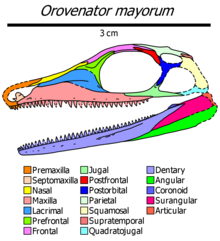Orovenator is an extinct genusofdiapsid from Lower Permian (Artinskian stage) deposits of Oklahoma, United States. It is known from two partial skulls from the Richards Spur locality in Oklahoma. The holotype OMNH 74606 consists of a partial skull preserving snout and mandible, and the referred specimen, OMNH 74607, a partial skull preserving the skull roof, vertebrae and palatal elements. It was first named by Robert R. Reisz, Sean P. Modesto and Diane M. Scottin2011 and the type speciesisOrovenator mayorum. The generic name means "mountain", oro, in Greek in reference to the Richards Spur locality, which was mountainous during the Permian period and "hunter", venator, in Latin. The specific name honours Bill and Julie May. Orovenator is the oldest and most basal neodiapsid to date.[1]
| Orovenator
Temporal range: Artinskian, 289 Ma
↓ | |
|---|---|

| |
| Skull diagram | |
| Scientific classification | |
| Domain: | Eukaryota |
| Kingdom: | Animalia |
| Phylum: | Chordata |
| Class: | Reptilia |
| Clade: | Neodiapsida |
| Genus: | †Orovenator Reisz, Modesto & Scott 2011 |
| Type species | |
| †Orovenator mayorum | |

A 2018 redescription by David Ford and Roger Benson found that Orovenator shared many similarities with varanopids, a group of reptile-like tetrapods traditionally considered to be synapsids (amniotes more closely related to mammals than to modern reptiles). However, this proposed close relation between Orovenator and varanopids did not render Orovenator a synapsid; rather, it supported a placement for Varanopidae within Diapsida.[2] However, a 2021 study found that the morphology of the maxillary canal of Orovenator was dissimilar to that of the varonopid Heleosaurus, which resembled that of synapsids, and instead was similar to those of other diapsids.[3]
{{cite journal}}: CS1 maint: multiple names: authors list (link)
This article about a Permian reptile is a stub. You can help Wikipedia by expanding it. |